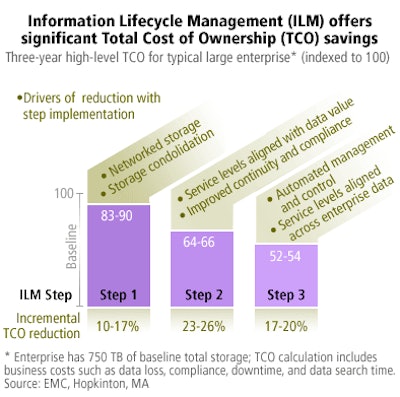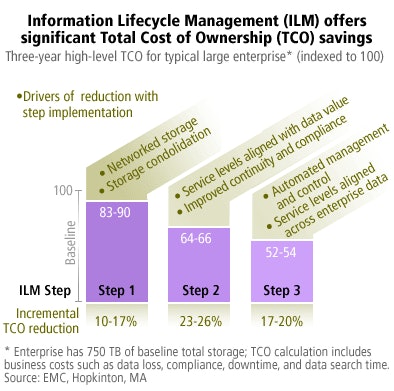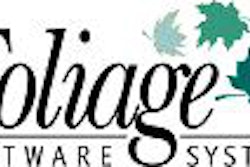
As custodian of one of the world’s largest repositories of current and historical medical study data, my firm is definitely in the information business. Our company handles massive volumes of fixed content, which includes internally and externally generated medical papers, clinical intelligence, and communications.
We needed a better and more economical way to manage our growing cache of information. Because the value of this information varies over time, and we have limited resources for managing it, the most valuable information must be given the highest priority in the management cycle, and this information must be the most quickly accessed. As the value of information decreases (for example, as clinical studies age) and increases (such as for compliance reasons) over time, that information should be automatically managed and moved to the appropriate storage repository.
By deploying an information life cycle management strategy, we were able to build a single information repository that serves multiple users, functions, and customer touch-points simultaneously without the usual amount of infrastructure churn. Today, we can seamlessly match information to the most appropriate storage resources on the basis of its value to the business.
And we can manage that storage more efficiently, which enables us to reduce the cost of delivering information faster by increasing the speed of our searching functionality. This results in higher customer satisfaction and significant beneficial impact to the bottom line.

While implementing an information life cycle management strategy, we learned six key lessons.
View IT management as a core competency and get buy-in from management
When developing an information life cycle management strategy, it is very important to involve the company’s senior management team so they understand that information is a key asset that needs to be managed in a collective way. This will avoid going in the direction of a piecemeal, nonintegrated solutions approach that invariably becomes labor-intensive.
Without management buy-in, it is impossible to deliver an integrated strategy. Getting buy-in from senior management is really a matter of building confidence in accepting IT management as a business partner with an equal vote at the board table. IT management should be viewed as a core business competency.
Make the strategy native to everything you do
To benefit from an information life cycle management strategy, it is important to make information life cycle management native to everything you do. We accomplished this by carefully planning around our infrastructure. We thoroughly understood business goals and the advantages various technologies would bring to achieve those goals.
Determine the value of your information
One of the first steps is to understand the duration and the value of your information at each phase in the life cycle, thereby determining your service-level requirements for performance, availability, compliance, and so on. We started from a business perspective and determined the value of information to various groups and processes within the company.
The team gained an understanding about the duration of the time in which information remained within each phase of its life cycle. Both were accomplished through a series of interviews with stakeholders, which yielded important specifics about what information required instantaneous access; where slower access was acceptable; and when it was best to archive.
Leverage integrated solutions
If you recognize that information is a core company asset similar to physical plants, for example, then you really understand the value of an integrated storage solution. You’re really storing and managing critical company assets efficiently.
We use a full suite of management tools and technology to allow us to move data seamlessly between platforms. While every aspect is not currently in place, we now have a planning cycle that allows us to leverage the solutions that can solve problems; this frees us from being bound to a single technology.
All of our content is managed through enterprise content management software, which enables the optimal management of information based on user needs and the available underlying infrastructure. The architecture of our storage infrastructure was also designed to match the appropriate storage platform with the appropriate information as its value changes.
Our databases and most valuable information that require the fastest access reside on our tier-one platform, for the best performance at the best price. As the information ages and levels of access slow down, data is stored on content-addressed storage. Our solution uses object-oriented technology that enables our company to acquire content at varying rates without allocating additional resources to manage that content.
Our implementation simplifies the management, security, distribution, and exchange of large volumes of content; adds indexing to the documents; and uses the company’s Microsoft SQL Server databases to manage that indexing. When information reaches a point where it is seldom needed, it is archived on more traditional types of magnetic media for even greater savings.
With ever-increasing regulatory mandates requiring more proactive measures, choosing an infrastructure that has built-in compliance capabilities is important.
Tight integration among all the components of our strategy also simplifies the movement of data between platforms without disrupting operations. This is a key element for effective information life cycle management, and it opens the door to future automation of the management process.
Use investments in your existing environment
Our existing assets will continue to be used for developmental and nonmission-critical projects, but ultimately, they will be migrated away from the production environment. This will enable us to focus all new activity on our information life cycle management environment and our core technology, which will allow us to grow the business without disruption for infrastructure upgrades.
Treat information life cycle management as the next emerging standard
Information life cycle management should be considered as an emerging new standard and process. It should be added to core competencies in the data center to ensure the IT team is focused on business objectives and fully understands the various types of information and their life cycles.
Our information life cycle management strategy helped us reduce support staff by 30% while increasing throughput by 20%. This boosted profitability by approximately 10%, and these results were directly attributable to tightly integrated solutions. In addition, we expanded our services to include Web access and search options for pharmaceutical and healthcare customers who rely on this information to improve business and provide better care.
The future of information life cycle management will become a core competency in all business planning. Having an information life cycle management process and strategy allows business processes to interact with the infrastructure, ensuring maximum business opportunity and optimal leveraging of information without the risk of failure.
By Robert TerdemanAuntMinnie.com contributing writer
April 1, 2004
Robert Terdeman is currently the vice president, chief information architect, of Rogers Communications in Toronto. He has served as chief technology officer and senior vice president of Rogers Medical Intelligence Solutions of New York City.
Related Reading
Task automation drives workflow enhancement, March 15, 2003
SCAR members offer solutions for data deluge, February 24, 2004
Data conversion specification aids in DICOM data migration, December 22, 2003
UCLA’s strategy on long-term image storage yields results in pricing negotiations, December 4, 2003
Assessment planning improves PACS performance, August 11, 2003
Copyright © 2004 EMC

















